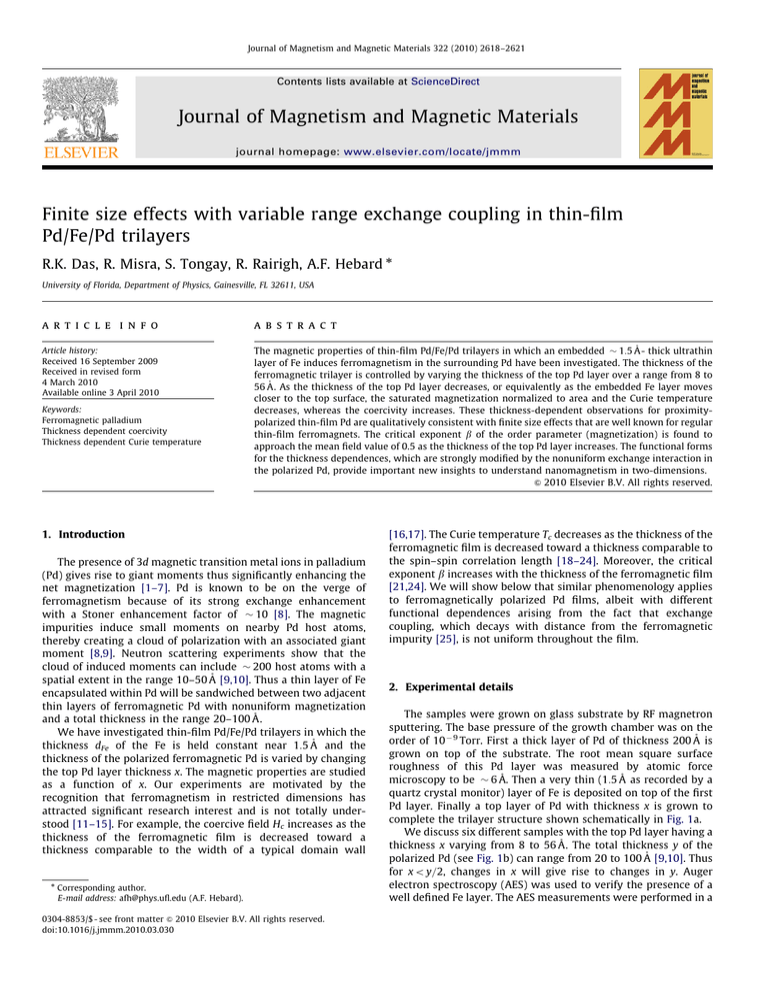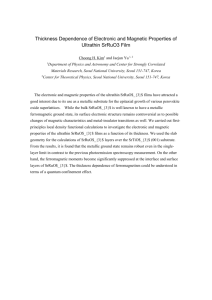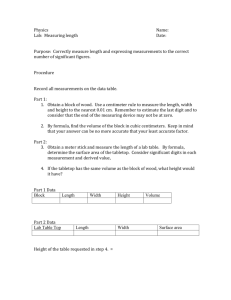
ARTICLE IN PRESS
Journal of Magnetism and Magnetic Materials 322 (2010) 2618–2621
Contents lists available at ScienceDirect
Journal of Magnetism and Magnetic Materials
journal homepage: www.elsevier.com/locate/jmmm
Finite size effects with variable range exchange coupling in thin-film
Pd/Fe/Pd trilayers
R.K. Das, R. Misra, S. Tongay, R. Rairigh, A.F. Hebard University of Florida, Department of Physics, Gainesville, FL 32611, USA
a r t i c l e in f o
a b s t r a c t
Article history:
Received 16 September 2009
Received in revised form
4 March 2010
Available online 3 April 2010
The magnetic properties of thin-film Pd/Fe/Pd trilayers in which an embedded 1:5 Å- thick ultrathin
layer of Fe induces ferromagnetism in the surrounding Pd have been investigated. The thickness of the
ferromagnetic trilayer is controlled by varying the thickness of the top Pd layer over a range from 8 to
56 Å. As the thickness of the top Pd layer decreases, or equivalently as the embedded Fe layer moves
closer to the top surface, the saturated magnetization normalized to area and the Curie temperature
decreases, whereas the coercivity increases. These thickness-dependent observations for proximitypolarized thin-film Pd are qualitatively consistent with finite size effects that are well known for regular
thin-film ferromagnets. The critical exponent b of the order parameter (magnetization) is found to
approach the mean field value of 0.5 as the thickness of the top Pd layer increases. The functional forms
for the thickness dependences, which are strongly modified by the nonuniform exchange interaction in
the polarized Pd, provide important new insights to understand nanomagnetism in two-dimensions.
& 2010 Elsevier B.V. All rights reserved.
Keywords:
Ferromagnetic palladium
Thickness dependent coercivity
Thickness dependent Curie temperature
1. Introduction
The presence of 3d magnetic transition metal ions in palladium
(Pd) gives rise to giant moments thus significantly enhancing the
net magnetization [1–7]. Pd is known to be on the verge of
ferromagnetism because of its strong exchange enhancement
with a Stoner enhancement factor of 10 [8]. The magnetic
impurities induce small moments on nearby Pd host atoms,
thereby creating a cloud of polarization with an associated giant
moment [8,9]. Neutron scattering experiments show that the
cloud of induced moments can include 200 host atoms with a
spatial extent in the range 10–50 Å [9,10]. Thus a thin layer of Fe
encapsulated within Pd will be sandwiched between two adjacent
thin layers of ferromagnetic Pd with nonuniform magnetization
and a total thickness in the range 20–100 Å.
We have investigated thin-film Pd/Fe/Pd trilayers in which the
thickness dFe of the Fe is held constant near 1:5 Å and the
thickness of the polarized ferromagnetic Pd is varied by changing
the top Pd layer thickness x. The magnetic properties are studied
as a function of x. Our experiments are motivated by the
recognition that ferromagnetism in restricted dimensions has
attracted significant research interest and is not totally understood [11–15]. For example, the coercive field Hc increases as the
thickness of the ferromagnetic film is decreased toward a
thickness comparable to the width of a typical domain wall
Corresponding author.
E-mail address: afh@phys.ufl.edu (A.F. Hebard).
0304-8853/$ - see front matter & 2010 Elsevier B.V. All rights reserved.
doi:10.1016/j.jmmm.2010.03.030
[16,17]. The Curie temperature Tc decreases as the thickness of the
ferromagnetic film is decreased toward a thickness comparable to
the spin–spin correlation length [18–24]. Moreover, the critical
exponent b increases with the thickness of the ferromagnetic film
[21,24]. We will show below that similar phenomenology applies
to ferromagnetically polarized Pd films, albeit with different
functional dependences arising from the fact that exchange
coupling, which decays with distance from the ferromagnetic
impurity [25], is not uniform throughout the film.
2. Experimental details
The samples were grown on glass substrate by RF magnetron
sputtering. The base pressure of the growth chamber was on the
order of 10 9 Torr. First a thick layer of Pd of thickness 200 Å is
grown on top of the substrate. The root mean square surface
roughness of this Pd layer was measured by atomic force
microscopy to be 6 Å. Then a very thin (1:5 Å as recorded by a
quartz crystal monitor) layer of Fe is deposited on top of the first
Pd layer. Finally a top layer of Pd with thickness x is grown to
complete the trilayer structure shown schematically in Fig. 1a.
We discuss six different samples with the top Pd layer having a
thickness x varying from 8 to 56 Å. The total thickness y of the
polarized Pd (see Fig. 1b) can range from 20 to 100 Å [9,10]. Thus
for x o y=2, changes in x will give rise to changes in y. Auger
electron spectroscopy (AES) was used to verify the presence of a
well defined Fe layer. The AES measurements were performed in a
ARTICLE IN PRESS
R.K. Das et al. / Journal of Magnetism and Magnetic Materials 322 (2010) 2618–2621
2619
Fig. 1. (a) Multilayer structure of a Pd/Fe/Pd trilayer. The bottom layer of Pd is 200 Å thick. The thickness of the Fe layer is 1:5 Å as recorded by the quartz crystal monitor.
The thickness x of the top layer of Pd is varied from 8 to 56 Å. (b) Magnetic structure. The total thickness y of polarized Pd is in the range 20–100 Å (shaded red area). Thus
by varying x, it is possible to vary the thickness y of the polarized ferromagnetic Pd layer, Physical structure. (c) Intensity of Fe3 (703.0 eV) LMM Auger electron peak plotted
as a function of material removed by argon sputtering. The data (solid black circles) are fit to a Gaussian distribution (red line). The full width half maximum value of 1:85 Å
is consistent with crystal monitor measurements, Auger electron spectroscopy. (For interpretation of the references to color in this figure legend, the reader is referred to
the web version of this article.)
Fig. 2. The saturation magnetization normalized to the area of the sample MsA
shows a smooth increase with increasing thickness x. The experimental data are
shown as solid black circles and the dashed black line is a guide to the eye.
Saturation to a constant value occurs near 30 Å (vertical arrow).
10 10 Torr vacuum at sequential intervals following removal
of sub angstrom amounts of Pd using an Argon etch. The
depth profile of the high intensity Fe3 (703.0 eV) LMM
Auger electron peak of Fig. 1c shows that the Fe is embedded
in the Pd as a distinct 2D layer with a FWHM thickness of 1:8 Å.
All of these steps were performed without breaking
vacuum.
Measurements of the magnetization M (Fig. 2) were performed
using a quantum design MPMS system. The magnetic field H was
along the plane of the substrate. Since the magnetization
measurements were ex situ, x was constrained to be 48 Å;
otherwise the exposure of the sample to air caused unwanted
oxidation of the Fe. The magnetic parameters Hc(x) (Fig. 3) and
Tc(x) (Fig. 4) are calculated, respectively, from magnetization
loops taken at 10 K (see inset of Fig. 3) and linear extrapolations of
the temperature-dependent magnetization taken at H¼20 Oe (see
inset of Fig. 4). The magnetic contribution from the bottom
ferromagnetic Pd layer is independent of x, since y=2 o 200 Å, the
constant thickness of the bottom layer.
Fig. 3. The coercive field Hc shows a strong increase as the thickness x of the top
layer of the Pd decreases. The data are shown as solid black circles and the black
solid line is a power law fit with exponent Z ¼ 2:3ð 7 0:1Þ. The inset shows
magnetization loops at T ¼ 10 K for x ¼ 8 Å (solid black squares) and x ¼ 56 Å
(solid red circles). (For interpretation of the references to color in this figure
legend, the reader is referred to the web version of this article.)
3. Results and discussion
For large values of x, the thickness y of the combined polarized
ferromagnetic Pd layers and the associated saturated magnetization M ¼Ms will reach a constant value. This expectation is borne
out in Fig. 2 which shows the x-dependence of saturated
magnetization MsA normalized to sample area. We note that this
normalized saturated magnetization MsA(x) increases with increasing x as the total amount of polarized Pd increases. The onset
of saturation, near x ¼ 30 Å indicates that the polarization cloud
including the embedded Fe layer is 60 Å thick. This value is
consistent with previous observation [10]. The increase of MsA
with x shown in Fig. 2 is thus straightforward to understand. As x
increases the thickness of the top polarized ferromagnetic Pd
layer increases with a concomitant increase of magnetic material
in the system. Variation of x clearly controls the thickness of the
polarized ferromagnetic Pd layer. When normalized to the
number of Fe atoms present, the saturated magnetization
ARTICLE IN PRESS
2620
R.K. Das et al. / Journal of Magnetism and Magnetic Materials 322 (2010) 2618–2621
Fig. 4. The Curie temperature Tc rapidly increases with increasing x. Data are
shown as solid black circles and the dashed black line is a guide to the eye.
Saturation to a constant value occurs near 20 A (vertical arrow) The inset with Tc
˚
indicated by the vertical arrow shows the temperature-dependent magnetization
taken in a field H¼ 20 Oe.
MsA ¼ 1:1 104 emu=cm2 corresponds to 9.2 mB per Fe atom, in
close agreement with previous observations of the giant moment
of Fe in Pd to be near 10 mB [9].
Modeling the x dependence of MsA(x) shown in Fig. 2 for our
Pd/Fe/Pd trilayers is not straightforward. For regular ferromagnets
with Ms uniform throughout the thickness, we would expect
MsA(x) to be linear in x; clearly it is not. A reasonable model will
incorporate an exchange interaction J that decays radially with
the distance from the point ferromagnetic impurity [25,26]. This
complication requires modeling J as a function of distance x from
the plane of impurity. A starting point would be to write the
magnetization M is a function of J [27],
Ms
½g mB H þ 2pMJðxÞ ,
ð1Þ
MðH,T,xÞ ¼ Ms Bs
kB T
where Bs is the Brillouin function and p is the number of the
nearest neighbors beyond which J is zero. In principle the
experimentally determined values of M(H,T,x) can be fit to
Eq. (1) to find the best fit values of J(x) for different values of
the parameter p. We have not performed such an analysis.
Fig. 3 shows the behavior of the coercivity Hc(x) as a function
of x (solid black circles). The data are well described by a powerlaw dependence (solid black line), Hc ðxÞpxZ , where the exponent
Z ¼ 2:3ð 70:1Þ is close to the ratio 7/3. Similar power-law behavior
reveals itself in regular ferromagnetic thin films where Z has a
somewhat smaller value varying from 0.3 to 1.5 [13]. Because Z
depends strongly on strain, roughness, impurity, and the nature of
the domain wall (Bloch or Neel type) [13], it is not surprising to
see a wide variation in Z. Neel predicted for example that for
Bloch domain walls, Hc of a ferromagnetic thin film should vary as
x 4/3 when the thickness x of the film is comparable to the
domain wall thickness w [16]. For the case of Neel walls, Hc
depends only on the roughness of the film and does not depend
on film thickness [14]. The variation of Hc(x) becomes particularly
pronounced when the film thickness becomes comparable to w.
A qualitative understanding of the steeper Hc(x) dependence
becomes evident by recognizing that the formation of domain
structure is driven by the reduction of long range magnetostatic
energy which at equilibrium is balanced by shorter range
exchange and anisotropy energy costs associated with the spin
orientations within a Bloch
or Neel domain wall. Domain wall
pffiffiffiffiffiffiffiffiffi
thickness is given by w ¼ A=K [19,28], where K is the crystalline
anisotropy constant and A is the exchange stiffness, proportional
to the exchange energy, J [29]. The domain wall size w increases
for decreasing K and increasing J. If K, which depends on the
relatively constant spin–orbit interaction [27] within the Pd
component of the Pd/Fe/Pd trilayers, remains constant, then
variations in w are dominated by variations in J. Thus as x
decreases toward zero, the increase in J [25] gives rise to an
increase in w which in turn gives rise to a more rapid increase in
Hc than would be seen in regular ferromagnets with constant J. As
discussed above, this rapid variation with Z 7=3 is observed
experimentally.
The data in Fig. 4 show that Tc increases as x increases and
reaches a relatively constant value near x ¼ 20 Å. The dashed black
line is a guide to the eye and is qualitatively similar to the
behavior of MsA(x) shown in Fig. 2 which saturates at a larger
value near 30 Å. These observations are again qualitatively
consistent with the finite size effect associated with critical
phenomena in ferromagnets [18–20]. Although the data are not of
sufficient quality to distinguish the power-law behavior that is
predicted for finite size effects [18–20], we expect that the
dependence is further complicated by the previously discussed
dependence of J on x in polarized ferromagnetic Pd. The behavior
of Tc(x) suggests that Pd/Fe/Pd trilayer should be treated as a
single layer with a well defined spin–spin correlation length. If the
Pd layers are treated separately, then the bottom layer with fixed
thickness y/2 would have a Tc equal to the highest Tc of the top
layer. In this case the overall measurement would not show a
strong change in Tc as a function of x, since the Tc of the bottom
layer would dominate for all x.
We note that for our planar geometry, Tc decreases with
decreasing thickness as has also been shown for thin-film Ni [18]
and epitaxial thin-film structures based on Ni, Co and Fe [19]. On
the other hand Tc increases with decreasing size of ferrimagnetic
MnFe2O4 nanoscale particles with diameters in the range 5–26 nm
[20]. This increase of Tc with decreasing size is attributed to finite
size scaling in three dimensions where all three dimensions
simultaneously collapse [20]. In our two-dimensional planar thin
films only one of the dimensions, the thickness, collapses and Tc
decreases rather than increases in accord with the observations of
previous studies [18,19].
The order parameter (magnetization) is found to be linear
when plotted as a function of ð1T=Tc Þb as shown in Fig. 5 for all
six samples. The data are taken in a small applied magnetic field
of 20 Oe. The linear behavior is observed over a broad range of
Fig. 5. Behavior of magnetization as a function of ð1T=Tc Þb where b is listed in
the legend for each film. The inset shows that b increases slowly and approaches
the mean field value of 0.5 for large x.
ARTICLE IN PRESS
R.K. Das et al. / Journal of Magnetism and Magnetic Materials 322 (2010) 2618–2621
temperatures below Tc. The exponent b is determined from the
slope of the straight line when magnetization is plotted as a
function of (1 T/Tc) on logarithmic scales. As shown in the inset,
b increases smoothly with increasing x. This behavior again is
qualitatively in agreement with regular ferromagnetic thin films
[21,24] where b also increases with thickness. In the case of
polarized ferromagnetic Pd we find b 0:5. This is larger
compared to regular ferromagnets [21,24]. The value of b varies
from 0.44 for small x and approaches the mean field value of 0.5
as x increases (inset of Fig. 5). The mean field value is generally
not seen in experiments for regular ferromagnets, instead b is
found to be either 0:125 for two-dimensional spin systems or
0:325 for three-dimensional spin systems [21,24]. Our
observation of mean field behavior is not understood, since the
Pd/Fe/Pd system is complicated due to the nonuniform exchange
coupling, J, which depends on the distance from the Fe layer.
4. Conclusions
In conclusion, we have characterized the magnetic properties
of thin-film Pd/Fe/Pd trilayers and determined that critical size
effects apply to ‘ferromagnetic’ Pd where the ferromagnetism is
induced by proximity to an underlying ultrathin Fe film. The
critical size, or equivalently the critical thickness, is controlled by
varying the thickness x of the top Pd layer. The dependences on
film thickness of the coercive field Hc, the Curie temperature Tc
and critical exponent b are in qualitative agreement with finite
size effects seen in regular ferromagnetic films where the
exchange coupling J is constant throughout the film. The results
presented here increase our understanding of nanomagnetism in
ultrathin systems by showing that the spatial variations of J in
proximity coupled Pd have a pronounced influence on the form of
thickness-induced variations, namely, a nonlinear dependence of
MsA(x), an unusually strong power-law dependence of Hc(x), a
rapidly saturating dependence of Tc(x) and a mean field critical
behavior of magnetization ðb 0:5Þ.
Acknowledgments
This research was supported by the NSF under Grant number
DMR-0704240 and as a part of the NSF Nanoscale Interdisciplinary Research Team Project under Grant number DMR-0403480.
We thank E. Lambers, D. Kumar and P. Kumar for useful
discussions and technical assistance.
References
[1] R. Bozorth, D. Davis, P. Wolff, J. Wernick, V. Compton, Ferromagnetism in
dilute solutions of cobalt in palladium, Physical Review 122 (1961) 1157.
[2] J. Crangle, Ferromagnetism in Pd-rich palladium–iron alloys, Philosophical
Magazine 5 (1960) 335.
[3] J. Crangle, W. Scott, Dilute ferromagnetic alloys, Journal of Applied Physics 36
(1965) 921.
2621
[4] G. Nieuwenh, Ferromagnetic transition temperature of dilute Pd–Co, Pd–Fe
and Pd–Mn alloys, Physics Letters A 43 (1973) 301.
[5] G. Nieuwenhuys, Magnetic-behavior of cobalt, iron and manganese dissolved
in palladium, Advances in Physics 24 (1975) 515.
[6] L. Cheng, Z. Altounian, D. Ryan, J. Strom-Olsen, Enhanced Fe moment at Pd/Fe
interfaces studied by low-temperature conversion electron Mossbauer
spectroscopy, Journal of Applied Physics 91 (10, Part 2) (2002) 7188–7190.
[7] J. Cable, E. Wollan, W. Koehler, Distribution of magnetic moments in Pd-3d
and Ni-3d alloys, Physical Review 138 (3A) (1965) A755.
[8] A. Oswald, R. Zeller, P. Dederichs, Giant moments in palladium, Physical
Review Letters 56 (1986) 1419.
[9] G. Low, T. Holden, Distribution of ferromagnetic polarization induced by iron
and cobalt atoms in palladium, Proceedings of the Physical Society of London
89 (1966) 119.
[10] L. Cheng, Z. Altounian, D. Ryan, J. Strom-Olsen, M. Sutton, Z. Tun, Pd
polarization and interfacial moments in Pd–Fe multilayers, Physical Review B
69 (2004) 144403.
[11] N. Chechenin, E. van Voorthuysen, J. De Hosson, D. Boerma, Variation of
structure and magnetic properties with thickness of thin Co59Fe26Ni15 films,
Journal of Magnetism and Magnetic Materials 290 (2005) 1539.
[12] H. Min, S. Kim, M. Li, J. Wedding, G. Wang, Thickness-dependent coercivity of
ultrathin Co films on a rough substrate: Cu-buffered Si(111), Surface Science
400 (1998) 19.
[13] I. Tabakovic, V. Inturi, S. Riemer, Composition, structure, stress, and coercivity
of electrodeposited soft magnetic CoNiFe films—thickness and substrate
dependence, Journal of the Electrochemical Society 149 (2002) C18.
[14] S. Tofail, Z. Rahman, A. Rahman, R. Mahmood, Influence of nanoporosity and
roughness on the thickness-dependent coercivity of iron nanonetworks,
Monatshefte Fur Chemie 133 (2002) 859.
[15] I.W. Wolf, Composition and thickness effect on magnetic properties of
electrodeposited nickel–iron thin films, Journal of the Electrochemical
Society 108 (1961) 959.
[16] L. Neel, Remarques sur la theorie des proprietes magnetiques des couches
minces et des grains fins, Journal De Physique Et Le Radium 17 (1956) 250.
[17] C. Tiller, G. Clark, Coercive force vs thickness for thin films of nickel–iron,
Physical Review 110 (1958) 583.
[18] H. Lutz, J. Gunton, H.K. Schurman, J. Croe, T. Mihalisi, Influence of finite size
on critical phenomena in Ni films, Solid State Communications 14 (1974)
1075.
[19] C.A.F. Vaz, J.A.C. Bland, G. Lauhoff, Magnetism in ultrathin film structures,
Reports on Progress in Physics 71 (2008) 056501.
[20] Z. Tang, C. Sorensen, K. Klabunde, G. Hadjipanayis, Size-dependent curietemperature in nanoscale MnFe2O4 particles, Physical Review Letters 67
(1991) 3602.
[21] Y. Li, K. Baberschke, Dimensional crossover in ultrathin Ni(111) films on
W(110), Physical Review Letters 68 (8) (1992) 1208–1211.
[22] R. Zhang, R. Willis, Thickness-dependent Curie temperatures of ultrathin
magnetic films: effect of the range of spin–spin interactions, Physical Review
Letters 86 (12) (2001) 2665–2668.
[23] M. Farle, K. Baberschke, U. Stetter, A. Aspelmeier, F. Gerhardter, Thickness-dependent curie-temperature of and its dependence on Gd(0001)/
W(110) the growth-conditions, Physical Review B 47 (17) (1993)
11571–11574.
[24] F. Huang, M. Kief, G. Mankey, R. Willis, Magnetism in the few-monolayers
limit—a surface magnetooptic Kerr-effect study of the magnetic-behavior of
ultrathin films of Co, Ni, and Co–Ni alloys on Cu(100) and Cu(111), Physical
Review B 49 (6) (1994) 3962–3971.
[25] M. Stringfe, Spin-wave stiffness of dilute iron–palladium alloys, Journal of
Physics Part C Solid State Physics 1 (1968) 1699.
[26] T. Moriya, Spin polarization in dilute magnetic alloys—with particular
reference to palladium alloys, Progress of Theoretical Physics 34 (3) (1965)
329.
[27] A. Aharoni, Introduction to the Theory of Ferromagnetism, Oxford University
Press Inc. Great Clarendon Street, Oxford, 1996.
[28] R. Skomski, Nanomagnetics, Journal of Physics—Condensed Matter 15 (2003)
R841.
[29] M. Pajda, J. Kudrnovsky, I. Turek, V. Drchal, P. Bruno, Ab initio calculations of
exchange interactions, spin-wave stiffness constants, and curie temperatures
of Fe, Co, and Ni, Physical Review B 64 (2001) 174402.







